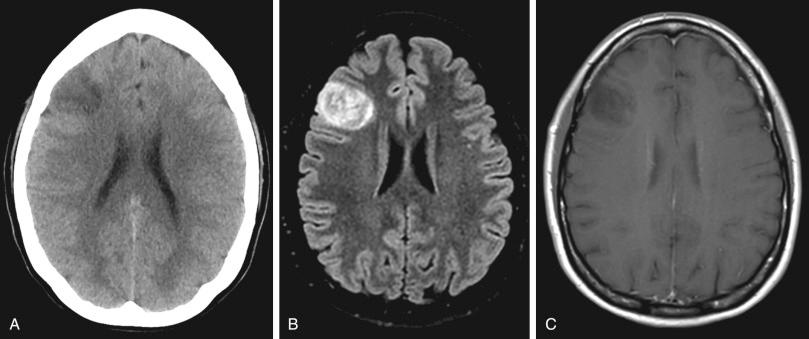Physical Address
304 North Cardinal St.
Dorchester Center, MA 02124
The term low-grade glioma (LGG) is used to describe World Health Organization (WHO) grade II gliomas, including diffuse astrocytomas, oligodendrogliomas, and oligoastrocytomas. Unlike high-grade gliomas, LGGs tend to grow slowly, but persistently, at roughly 3.5 mm per year. Although most of these tumors do not cause neurologic deficits at the time of diagnosis, they are locally invasive and frequently exhibit malignant degeneration into higher-grade gliomas. Ultimately, transformation into higher-grade tumors results in growth through the surrounding brain, neurologic deficits, and eventual death. Unlike high-grade gliomas, which tend to affect older patients, LGGs typically occur in younger adults.
Each year, 2000 to 3000 new cases of LGG are diagnosed in the United States, accounting for approximately 10% of newly diagnosed primary brain tumors (per Surveillance, Epidemiology and End Results Program [SEER] at the National Institutes of Health). LGG is a disease of younger patient populations, with a peak incidence in the 35- to 44-year-old age bracket.
LGGs typically present in supratentorial locations and have a tendency to occur in eloquent cortex. These tumors frequently present with first-time seizures and are occasionally diagnosed incidentally on imaging obtained for other reasons such as head trauma. They are presumed to grow slowly over relatively long periods of time, sometimes providing time for transfer of function to other nearby regions of the brain via plasticity. This process may explain the frequent absence of devastating neurologic deficits at the time these tumors are diagnosed.
Since the early 2000s, an improved understanding of the genetic changes driving tumorigenesis has allowed refined classification of brain tumors. Until recently they were categorized on the basis of cellular lineage, histologic features, cellular differentiation, and proliferation. In this system, histologic features were studied using common tissue staining techniques (hematoxylin and eosin stain or Nissl stain). In the 2007 WHO scheme, immunohistochemical markers were added as corollary studies to confirm the cellular lineage(s) of a tumor. Based on this system, which relies on histologic features in addition to immunohistochemical stains, tumors with astrocytic phenotype are classified differently than tumors with oligodendroglial features.
With advances in genetic studies, we now have a better understanding of tumorigenesis in the central nervous system. It has become clear that some tumors with disparate phenotypes, which were previously presumed to have different natural history, may in fact share common genetic changes that drive dedifferentiation and tumor formation. Because such commonalities tend to result in similar tumor behavior and outcome, the modern pathologic evaluation of these lesions now includes an analysis for these changes.
In 2016 WHO provided an update to the existing 2007 classification system for the tumors of the central nervous system. Reflecting the significant advances described earlier, this update incorporates histopathology and molecular genetic studies into definitions of diagnostic entities. In this new format, final diagnosis is based on a combination of the phenotypic and genotypic parameters. The introduction of this new integrated classification system led to finer subdivision of some of the prior histopathologic tumor classes based on the presence or absence of certain genetic markers. It is hoped that this more narrowed categorization will help to define tumor entities that are biologically homogenous and diagnostically accurate, ultimately improving prognostication and treatment. For example, in the 2007 WHO classification of brain tumors, diffuse astrocytoma was only a single tumor type. In the 2016 WHO update, these tumors were subdivided into diffuse astrocytomas with or without isocitrate dehydrogenase (IDH) mutation.
It is also hoped that integration of histopathologic data and molecular genetics will add a degree of objectivity to the diagnostic process that has previously been absent. For example, there has been considerable variation between institutes with regard to the frequency of diagnosing oligoastrocytomas, a mixed tumor constituting elements of both low-grade oligodendroglioma and astrocytoma. The 2016 update uses genetic criteria to designate these tumors as either astrocytoma (IDH mutant, ATRX wild-type, 1p/19q intact) or oligodendroglioma (IDH mutant, ATRX wild-type, 1p/19q co-deletion). At times, these changes may lead to discordance between histopathologic and genotypic findings. Per the current WHO update, in such situations, the genotypic findings trump the histopathologic diagnosis.
The most common presenting symptom of LGG tumors is a first-time unprovoked seizure; thus computed tomography (CT) scan is a common first-line diagnostic imaging modality. Because most of these tumors are slow growing, they may cause expansion, remodeling, or erosion of the calvarium. Although some LGG tumors may enhance on a contrast CT scan, they are mostly non- or mildly enhancing. LGGs rarely cause significant peritumoral edema.
Oligodendrogliomas tend to present as mixed-density masses, with calcifications (70%–90%) being a hallmark CT finding. Rarely, these tumors may have a cystic component (20%). Hemorrhage is an uncommon finding.
Low-grade diffuse astrocytomas manifest as ill-defined homogenous masses with rare calcifications. They seldom enhance with contrast on CT; if present, enhancement should raise the concern for malignant transformation (secondary high-grade glioma). See Figure 38.1 .

Become a Clinical Tree membership for Full access and enjoy Unlimited articles
If you are a member. Log in here